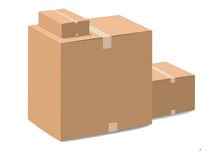
What is DIM Weight?
Posted On | June 12 2019
What is DIM Weight and What Does it Mean to Me?
Dimensional Weight is used to calculate the shipping cost of LARGER packages with lower weights, aka light packages that take up a lot of valuable space in a delivery truck or airplane.
As of June 23, 2019 Dimensional Weight (DIM) pricing was applied to Non-Lightweight Parcel Select, Priority Mail, and Priority Mail Express packages across all USPS Postal Zones.
Dimensional Weight is used by all the major carriers to calculate the shipping cost of larger packages with lower weights that take up a lot of valuable space in a delivery truck or airplane. If the calculated Dimensional Weight is higher than the actual weight you will be required to pay the higher amount.
FedEx, UPS and USPS all use the Dimensional Weight to price lighter packages. USPS offers the best Dimensional Weight pricing.
The USPS Dimensional Weight divisor is 166 while the divisor for UPS (139/166*) and FedEx is 139.
Here's a trick to remembering: The LOWER the divisor the more expensive it is to ship your package.
*UPS's divisor is 139 for daily rates and 166 for retail rates.
Businesses should be aware of Dimensional Weight pricing and try to fit packages in the SMALLEST packaging available. You can also explore Flat Rate shipping options to be sure that your shipments won't be charged off of their Dimensional Weight.
What exactly is Dimensional Weight (DIM Weight)?
- Dimensional Weight refers to how much space a package takes up in a truck or on an airplane during shipping.
- Dimensional Weight Pricing charges more for LARGE packages that weigh very little.
- Dimensional Weight Pricing only apples to packages larger than 1 CUBIC FOOT.
- Most E-Commerce packages are less than 1 CUBIC FOOT and are not subject to DIM Weight Pricing.
Example: There is a large USPS truck filled with 200 large boxes of pillows. Each one of those boxes of pillows weighs very little, maybe 3-4 lbs. each. Now let's imagine the same truck is instead filled with 200 boxes of shoes in small boxes. Each also weighs 3-4 lbs. The boxes of shoes, being smaller, take up maybe 20% of the space as the boxes of pillows, but being charged by weight alone, would cost the same amount for the Postal Service to transport.
So...in the same truck, 5 times the number of shoes (1000 boxes), could be shipped at the same time rather than the very large but very light 200 boxes of pillows which would generate 5 times the revenue for the same truckload.
To balance the difference between size and weight, the USPS has adopted a formula for determining what the minimum shipping weight is for a box OVER 1 cubic foot in size, the Dimensional Weight, and uses that higher rate for large boxes that weigh very little.
The USPS has a formula for setting DIM rates: A package dimensions are multiplied, Length X Width X Height. If the result if more than 1 cubic foot, (1728 cubic inches), divide the result by 166 to determine the Dimensional Weight. After June 23rd, the divisor will be 166.
You can do the math by hand or speed things up by using Quadient's DIM Weight Calculator.
If the postage rate for the Dimensional Weight is higher than the standard rate, that rate will apply to that package. Thankfully, our software automatically compares dimensions with weight to determine if Dimensional Weight Pricing is needed.
One (1) Cubic Foot may sound small, but is quite a large box. As a CUBE, a cubic foot is 12" x 12" x 12". Most boxes are not cubes and any size box whose sides, when multiplied together equal 1 cubic foot, or 1728 cubic inches, or less is fine.
Here is a common box size, 18" x 16" x 6", that is a common for goods sold online. When the length and width and height of this size box are multiplied together, it is 1728 cubic inches, exactly 1 cubic foot. Any box smaller than these dimensions is less than 1 cubic foot and not subject to Dimensional Weight Pricing.
Dimensional Weight may sound scary but if you are that person that ships large boxes that weigh very little, you can expect to pay more for shipping.
What is Considered a "Package"?
Per the USPS, if your mail piece isn't a postcard, letter or a flat (large envelope), then it is a parcel! Parcels are not just big boxes. A parcel is usually anything larger than 3" high x 6" long x 1/4" thick. However, when in doubt: Measure, measure, measure!
Most standard sized padded envelopes will be not subject to DIM weight. However, again, it is always important to measure your packaging to see if it is larger than 1 cubic foot (over 1,728 cubic inches) and therefore subject to Dimensional Weight pricing.
What Can I Do to Minimize the Effect of DIM Pricing?
1. Examine your products and the boxes you ship them in. Could they fit into a smaller box or padded envelope? The smaller the box you use will, generally, will reduce your shipping costs. Look into the USPS Flat Rate box. These boxes are charged one flat rate and are not subject to DIM Weight Pricing.
2. Our software is set to default to 1 cubic foot for Packages when no dimensions are entered. If you know your box is less than 1 cubic foot, select Packages. You don't have to do anything different when shipping. If you ship a package larger than 1 cubic foot without entering dimensions, any DIM charges will be subtracted from your postal account as an adjustment.
3. If you know, or think, your box is larger than 1 cubic foot, select LARGE PACKAGE and enter the dimensions of your box. Our software will compare the size, weight and distance to calculate the postage required.





